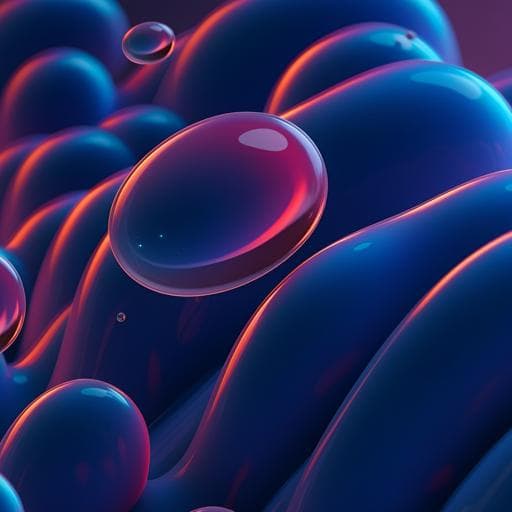
Engineering and Technology
Self-assembly of sustainable plant protein protofilaments into a hydrogel for ultra-low friction across length scales
O. Pabois, Y. Dong, et al.
This innovative research, conducted by a team of experts including Olivia Pabois and Jacob Klein, reveals a self-assembled, sustainable lubricant made from plant-based materials. Featuring unprecedented superlubricity, this groundbreaking material could revolutionize lubrication in various industries.
~3 min • Beginner • English
Introduction
Achieving superlubricity (friction coefficient < 0.01) is transformative for energy savings and biomedical applications. Oil-free superlubrication via hydration lubrication at moderate-to-high pressures, akin to conditions in biological systems (oral epithelium, synovial joints), offers a sustainable pathway. Existing aqueous lubricants demonstrating superlubricity often rely on synthetic components (vesicles, solid lubricants, polyzwitterionic brushes, amphiphilic surfactants) or synthetic hydrogels, limiting eco-friendliness. Plant-derived proteins present an abundant, lower-carbon-footprint alternative, and can be structured into functional materials (microgels, nanostructured films, amyloid fibrils). However, converting plant proteins into functional aqueous lubricants achieving superlubricity had not been demonstrated. The present study designs self-assembled plant protein-derived protofilaments integrated within a biopolymeric hydrogel network to create an advanced aqueous lubricant delivering superlubricity across length scales, using potato protein protofilaments electrostatically assembled with hydrating polysaccharide hydrogels.
Literature Review
The authors situate the work within the field of hydration lubrication, which has shown promise in achieving ultra-low friction in biological contexts, yet most superlubricious aqueous systems to date employ synthetic constructs (e.g., phosphatidylcholine liposomes, graphene or other solid lubricants, polyzwitterionic brushes, synthetic amphiphiles and hydrogels). Although recent hydrogel approaches can yield ultra-low friction, they often rely on synthetic polymers (e.g., polyacrylamide, zwitterionic copolymers) or lipid incorporation. Plant proteins have been explored for functional materials through physical ordering driven by hydrophobic and electrostatic interactions, including fibrillisation into amyloid-like structures from soy, pea, oat, and potato proteins. Prior studies also examined plant protein microgels for lubrication, but superlubricity using plant-based building blocks remained unrealized. This gap motivates a sustainable, biocompatible, plant-derived approach to hydration lubrication.
Methodology
Materials: Potato protein isolate (91%) was dispersed at 6.0 wt% in 10 mM citrate buffer (pH 3.0), stirred ~1.5 h, pH adjusted to 3.0 with 1 M HCl, centrifuged at 25,000 × g for 30 min, and supernatant heated at 65 °C for 30 min to form potato protein protofilaments (PoPF). Xanthan gum (XG) hydrogel (XGH, 1.5 wt%) was prepared by dispersing XG in 10 mM citrate buffer (pH 3.0) and shearing for 24 h at ~21 °C for complete hydration. Kappa-carrageenan hydrogel (KCH, 1.5 wt%) was prepared by heating 30 min at 95 °C in citrate buffer (pH 3.0) with shear. Self-assembly: PoPF was added dropwise to XGH or KCH under gentle stirring at 21 ± 2 °C to obtain 2:1 w/w polymer-to-protein mixtures (1.2 wt% XGH or KCH with 0.6 wt% PoPF). Characterization: - DLS and zeta potential: Zetasizer Ultra (25 °C) with 100× dilution in folded capillary cells. - TEM: Negative staining (2 wt% uranyl acetate) on glow-discharged carbon-coated copper grids; FEI Tecnai G2 Spirit T12 (120 kV). - AFM: Non-contact mode in liquid on mica using silicon nitride cantilever (k ≈ 0.35 N/m), samples incubated ~30 min before imaging in citrate buffer (pH 3.0). - SANS: SANS2D (ISIS, STFC) at 25 °C in 1 mm quartz cells; wavelength 1.75–16.5 Å, dual detectors at 2.4 and 4 m; q-range 0.004–1 Å⁻¹; data processed in MANTID; fits via unified model. - MD simulations: Coarse-grained MARTINI 3 model of PoPF built from patatin (PDB 1oxw) formed by 8 patatin units; equilibrated and simulated (NPT, 338 K, 1 bar) then back-mapped to all-atom AMBER; XG models (six-repeat GLYCAM-based) added (20 chains) to form XGH; production runs (100–250 ns, final 50 ns analyzed). A PDMS slab (amorphous) was constructed (435 chains of 13-mers) and equilibrated (800→350 K) to study PoPF/XGH adsorption and interactions at a hydrophobic interface; water model TIP3P; 150 mM NaCl. - Rheology: Rotational rheometry (stress-controlled, cone-plate CP2/60, 37 °C) to measure shear viscosity over 0.01–1000 s⁻¹. Extensional rheology via CaBER-1 (plate D0=6 mm; initial gap 3 mm, final 10 mm in 50 ms), measuring filament thinning, apparent extensional viscosity, and Trouton ratio; tests at 37 °C. - Macroscale tribology: PDMS ball-on-disk tribometer (37 °C) with non-charged hydrophobic PDMS contacts; contact pressure ~300 kPa; friction vs entrainment speed measured; minimum hydrodynamic film thickness analyzed. - Adsorption: QCM-D with PDMS-coated sensors; samples diluted 20×; adsorption and rinsing behavior monitored via Δf (5th overtone). - Nanoscale SFB: Mica–mica normal and shear force measurements in citrate buffer dispersions; normal force F(D)/R and shear force vs time and load recorded; pressures up to ~30 atm (~3 MPa). Replicates and reproducibility were noted for each technique.
Key Findings
- Structural assembly and patchiness: DLS showed monomodal PoPF distributions. TEM and AFM revealed long, curly nanofibrils formed from sphere-like patatin units (~20 nm diameter, 3–5 nm height) after 65 °C/30 min at pH 3.0. PoPF fibrils remained at protofilament stage (no twisted amyloid). XGH showed no topography on mica due to negative charge (ζ ≈ −40 mV) vs PoPF positive (ζ ≈ +30 mV). SANS: PoPF Rg = 75.4 ± 1.5 Å with fractal dimension ~3.3; XGH rod-like, Rg = 156.4 ± 4.1 Å; combined 2 XGH/PoPF exhibited rough objects Rg = 74.2 ± 2.5 Å, fractal dimension ~2.9, forming continuous interconnected filaments on surfaces, indicative of patchy XGH coating and PoPF-mediated surface binding. - MD insights: In solution, PoPF Rg = 46.1 ± 0.1 Å (eccentricity 0.06 ± 0.01). With XG, partial coating occurs (Rg = 44.8 ± 0.1 Å; eccentricity 0.15 ± 0.01), mainly interacting via patatin C-terminal cationic residues (e.g., Lys/Arg-rich 327–359) and residues 113–137. At PDMS, PoPF adsorbs via naked hydrophobic regions (residues ~72–90 and ~180–200), becoming more compact (Rg = 43.6 ± 0.1 Å) and more spherical (eccentricity 0.13 ± 0.01). XG bridges between PoPF in head-to-tail fashion, yielding fiber-like assemblies. - Rheology: All systems shear-thinned over 0.01–1000 s⁻¹. At 0.01 s⁻¹, viscosities: PoPF 1.3 ± 0.1 Pa·s; XGH 1006 ± 122 Pa·s; 2 XGH/PoPF 757 ± 23 Pa·s. At 1000 s⁻¹: XGH 0.052 ± 0.003 Pa·s; 2 XGH/PoPF 0.050 ± 0.002 Pa·s. Extensional rheology showed long-lived filaments for XGH and 2 XGH/PoPF; 2 XGH/PoPF had t_break = 0.67 ± 0.37 s vs XGH 0.51 ± 0.22 s; apparent extensional viscosity ~24.0 ± 9.1 Pa·s vs 44.2 ± 27.3 Pa·s; Trouton ratio 21.0 ± 2.8 vs 30.6 ± 6.8. - Macroscale tribology (PDMS, ~300 kPa, 37 °C): PoPF exhibited high friction up to μ = 1.18 ± 0.05 at 0.004 m/s; XGH reached μ ≈ 0.009 ± 0.002 at 0.1 m/s in hydrodynamic regime. The 2 XGH/PoPF self-assembly showed nearly speed-independent ultra-low friction, with μ ≈ 0.004 ± 0.005 in boundary regime (0.004 m/s), and friction independent of calculated film thickness, indicating robust boundary films. pH dependence: superlubricity retained below neutral pH; friction increased at pH 7.0 (both components negative, reduced complexation). Performance persisted at polymer/protein ratios from 2 to 0.5 and also with KCH substitution (with lower magnitude). QCM-D: 2 XGH/PoPF adsorbed ~3× more strongly to PDMS and remained after rinsing vs either component alone. - Nanoscale SFB (mica, up to ~3 MPa): PoPF showed long-range steric repulsion with D_HW ≈ 300 ± 1 nm (multilayer PoPF). XGH showed weak, short-range steric repulsion and complete squeeze-out (D_HW → 0 nm) at high compression. 2 XGH/PoPF showed repulsion onset near 500 nm, D_HW ≈ 200 nm, and no squeeze-out up to ~30 atm, indicating strong complex adsorption with some naked PoPF areas adhering to mica. Shear: PoPF and XGH exhibited relatively high μ (order 10⁻¹–10⁻⁰), attributed to poor hydration sliding (PoPF) or polymer bridging (XGH). In contrast, 2 XGH/PoPF yielded very low μ at high loads, of order 10⁻⁴–10⁻⁵ (e.g., μ ≈ 3.1×10⁻⁴, 2.1×10⁻⁴, 7.6×10⁻⁵ at different loads). - Overall lubrication: The study reports liquid-vanishing friction with μ ≈ 4×10⁻⁷ to 7×10⁻⁷ under 300 kPa to 3 MPa by synergistic action: uncoated PoPF regions anchor to surfaces (hydrophobic/counterion-release interactions) while exposed XGH provides hydration lubrication, functioning as a water-encapsulating macromolecular brush.
Discussion
The multiscale results demonstrate a synergistic mechanism wherein the patchy self-assembly of xanthan hydrogel onto potato protein protofilaments yields stable boundary layers that maintain ultra-low friction from macro- to nanoscale. Naked, hydrophobic domains on PoPF facilitate strong anchoring to both hydrophobic (PDMS) and negatively charged hydrophilic (mica) surfaces, as supported by MD contact maps and QCM-D adsorption. Simultaneously, XGH segments remain exposed to the interface, forming highly hydrated, brush-like layers that support hydration lubrication, minimizing energy dissipation during shear. This synergy contrasts with the poor lubrication of PoPF alone (high dissipation from protein layers sliding past each other) and XGH alone (weak adsorption and polymer bridging leading to higher friction and squeeze-out). The resulting boundary films in the 2 XGH/PoPF system are effective even at low surface separations and high contact pressures, showing friction largely independent of hydrodynamic film thickness at the macroscale and no squeeze-out at the nanoscale. The findings underscore the potential of plant-based, ecofriendly building blocks to achieve superlubricity in conditions relevant to biological contacts (oral, ocular, articular) while aligning with sustainability goals.
Conclusion
Potato protein, an abundant by-product from the starch industry, can be transformed into a highly functional aqueous lubricant achieving superlubricity across length scales. Electrostatic self-assembly of potato protein protofilaments with polysaccharide hydrogels (xanthan or carrageenan) produces continuous, filamentous networks with a patchy architecture. These structures deliver unmatched ultra-low friction (down to ~10⁻⁵–10⁻⁴ at the nanoscale and ~0.004 in boundary macroscale tests), and reported liquid-vanishing friction of ~10⁻⁷ under 300 kPa–3 MPa, via a synergistic mechanism: PoPF anchors to surfaces while exposed, highly hydrated XGH provides hydration lubrication. This sustainable, biocompatible route offers a platform for next-generation aqueous lubricants for energy and biomedical applications. Future work will extend the protofilament–hydrogel self-assembly concept to other plant proteins and assess performance across surfaces with varying hydrophobicity.
Limitations
Different model surfaces were used across techniques: hydrophobic PDMS for macrotribology, QCM-D, and MD simulations, versus hydrophilic, negatively charged mica for AFM and SFB. Although superlubricity persisted across these conditions and scales, this surface variability is a limitation. Additionally, while the systems were tested over a wide pressure range (hundreds of kPa to several MPa), real biological interfaces may present additional complexities (compositional heterogeneity, roughness, dynamics) not fully captured here.
Related Publications
Explore these studies to deepen your understanding of the subject.







